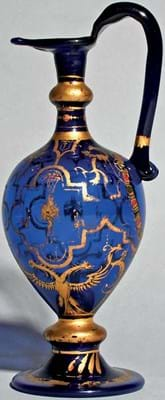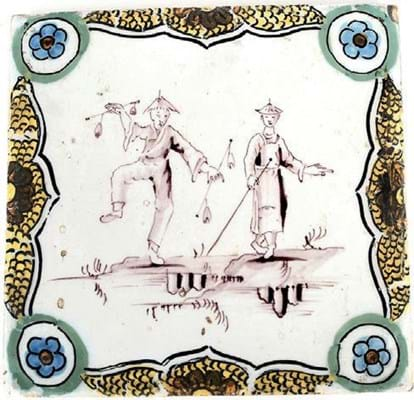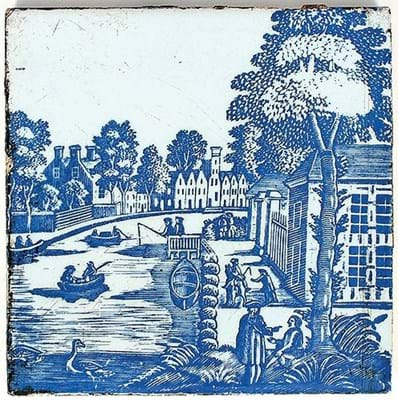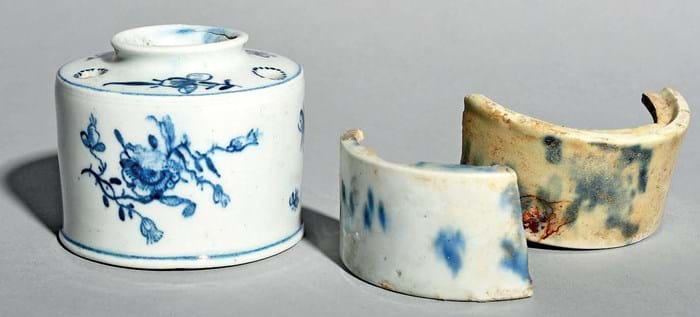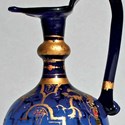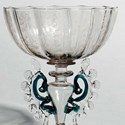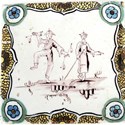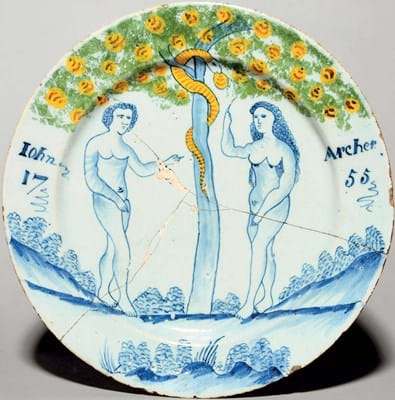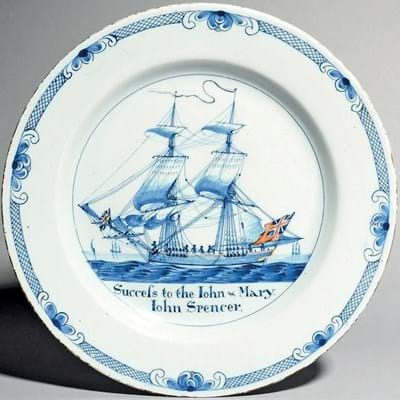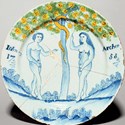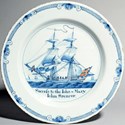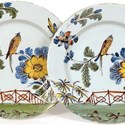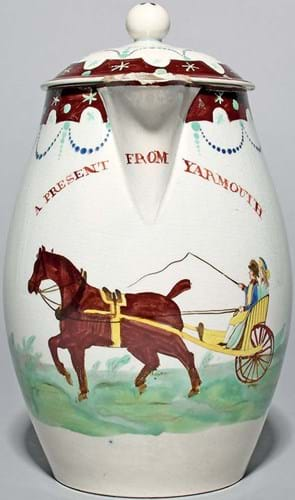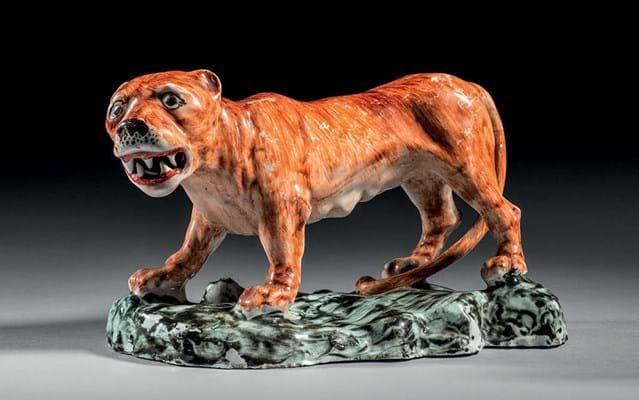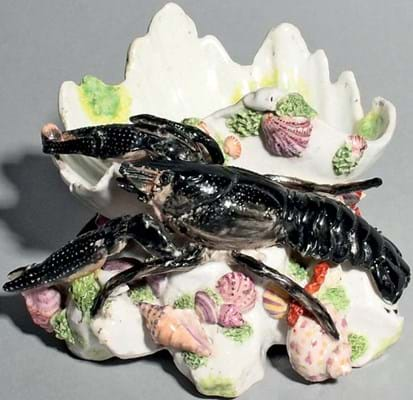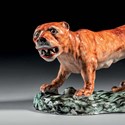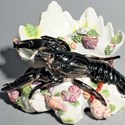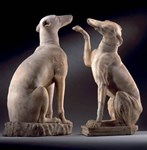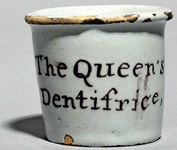“We knew we had good things to sell – it was just a question of when.”
Woolley & Wallis (25% buyer’s premium) was among the UK auction houses that – for reasons including logistics and reluctant vendors – chose not to hold online only sales during lockdown.
Instead, the firm is returning to the rostrum with a quick succession of ‘ready to go’ good-quality sales across a range of collecting disciplines. English and Continental Glass and Ceramics, headed by specialist Clare Durham, was the first on June 17.
Just nine people (and a well-behaved dog) were in the room for this ceramics event but a surprising number, more than 50 dealers and collectors, had viewed the sale by appointment in the days before.
“The feedback I was getting,” said Durham, “was that with their holidays cancelled and social diaries completely empty, people were keen to get out, handle some objects and a spend some spare cash on their collecting hobby.”
The glass section was dominated by four lots of early Venetian or façon de Venise glass consigned from the de Rothschild collection at Exbury House in Hampshire.
These pieces, probably first acquired by Alfred de Rothschild (1842-1918) at Halton House, included the front-cover lot: an 8in (20cm) cobalt blue façon de Venise ewer made in Italy for the Austrian market c.1560-90. The cold-painted gilt and wash enamel decoration of double-headed eagles and mythical creatures is far from typical for Venetian glass. European Glass from 1500-1800: The Ernesto Wolf Collection by Brigette Klesse and Hans Meyr references two similar examples.
This piece sold to a UK private buyer at £14,000 (estimate £2000-3000).
Pitched at £600-800 but sold for £8500, again to a private UK collector, was a 5in (23cm) winged goblet made in Venice or possibly in the Low Countries, c.1700. As well as floral diamond-point engraving across the fluted bowl, it was applied with pinched and scrolled ‘wings’ in turquoise and clear glass.
Durham said that this sale attracted a higher than usual number of private buyers. Lockdown boredom combined with the cancellation of fairs and other auctions had left them hungry to buy.
The ‘downtime’ might also have brought more eyeballs to the subject.
The English Ceramics Circle has been particularly busy of late. Although all physical meetings have been suspended for the foreseeable future, a busy programme of lectures conducted using Zoom video-conferencing is keeping collectors occupied.
Testament to their appeal has been the addition since April of 45 new members – an unheard-of number in a sector sometimes lamented for its declining audience.
West Country delft
A £41,000 private collection from the West Country was the source of some fine examples of English delftware at W&W.
Of particular note was a rare 10in (26cm) Bristol plate finely decorated with The Temptation and the inscription John Archer 1755.
This piece, illustrated in Louis Lipski and Michael Archer’s Dated English Delftware, was in visibly poor condition but perhaps the only named and dated example of this (relatively late) Adam and Eve type. Estimated at £2000-3000, it sold to a UK dealer at £6500.
A 14½in (36cm) Liverpool ship charger of the same period sold at £5000, again to the UK trade. Painted with a two-masted brig at sail – perhaps by William Jackson who specialised in maritime subjects – it has the inscription Success to the John and Mary and the name John Spencer.
The Lloyd’s Register of Shipping in 1764 records the John and Mary as a single deck brig with beams built in 1756 at Yarmouth, sailing to Leghorn under a Captain P Crombies. The owner is listed as J Spencer.
This particular dish, first sold by the Spencer family at Phillips in Bury St Edmunds in 1997, had failed to sell when last offered for sale at Bonhams in 2014 but was purchased shortly afterwards by the vendor for £3500.
Also probably made in Liverpool was a 9in (23cm) plate inscribed to the well in blue Success to the Old Boy at Gasting Thomas Knowles 1763. Four of these are pictured in Lipski & Archer, where the authors suggested the legend references The Old Boy tavern in Garstang, Lancashire. In decent condition save some rim chips, it took £2500 (estimate £800-1200).
From the same West Country collection was a fine group of creamwares and pearlwares. Again, documentary pieces commanded a premium.
A 6in (15cm) high creamware jug, painted in enamels with small flower sprigs around the inscription William Ellis, born May. 6, 1812, Chagford, sold on thesaleroom.com to a New Zealand buyer at £2200 (estimate £600-800).
The inscription is thought to refer to one of several generations of a family that worked the Stineal Farm in Chagford, a village on the edge of Dartmoor around 10 miles from Bovey Tracy where this jug was probably made.
Sold for a mid-estimate £950 to a US buyer was an 8in (20cm) pearlware beer jug and cover, c.1790, decorated with a couple riding in a pony and trap and the inscription A Present from Yarmouth.
It was probably painted in the workshop of William Absolon (1751-1815) of Yarmouth – the specialist glass and ceramics decorator who made a small fortune creating tourist souvenirs.
Not too much is known about his life but by 1808 he insured his house, shop and offices ‘adjoing neaer the Market Place’ for £1000.
Topping the porcelain in this sale was a rare and large 9in (23cm) Bow figure of a prowling lioness standing on a rocky base, c.1750-52.
Several pairs of figures left in the white are known, but this is just one of two recorded with naturalistic enamel decoration. It carried hopes of £15,000-20,000, but with a little latitude around the reserve the hammer fell to the UK trade at £13,000.
Animated competition emerged for another work best known ‘in the white’: a Chelsea crayfish salt c.1752-55. Based on a print after the rococo goldsmith Juste-Aurèle Meissonnier, the model was first made by Chelsea factory director Nicholas Sprimont (1716-71) in silver, c.1742, transferring it to the new medium of porcelain after 1745.
This polychrome enamel example, with some restoration, sold to a UK private collector at £7000 (estimate £2000-3000).
Formerly part of the Geoffrey Godden reference collection – and the example pictured in Godden’s book Lowestoft Porcelain – was a Lowestoft blue and white inkwell, c.1764, painted with small floral sprigs and scattered flying moths and insects.
Sold together with two inkwell sherds excavated from the factory site, it took £3600 (estimate £1000-2000).


